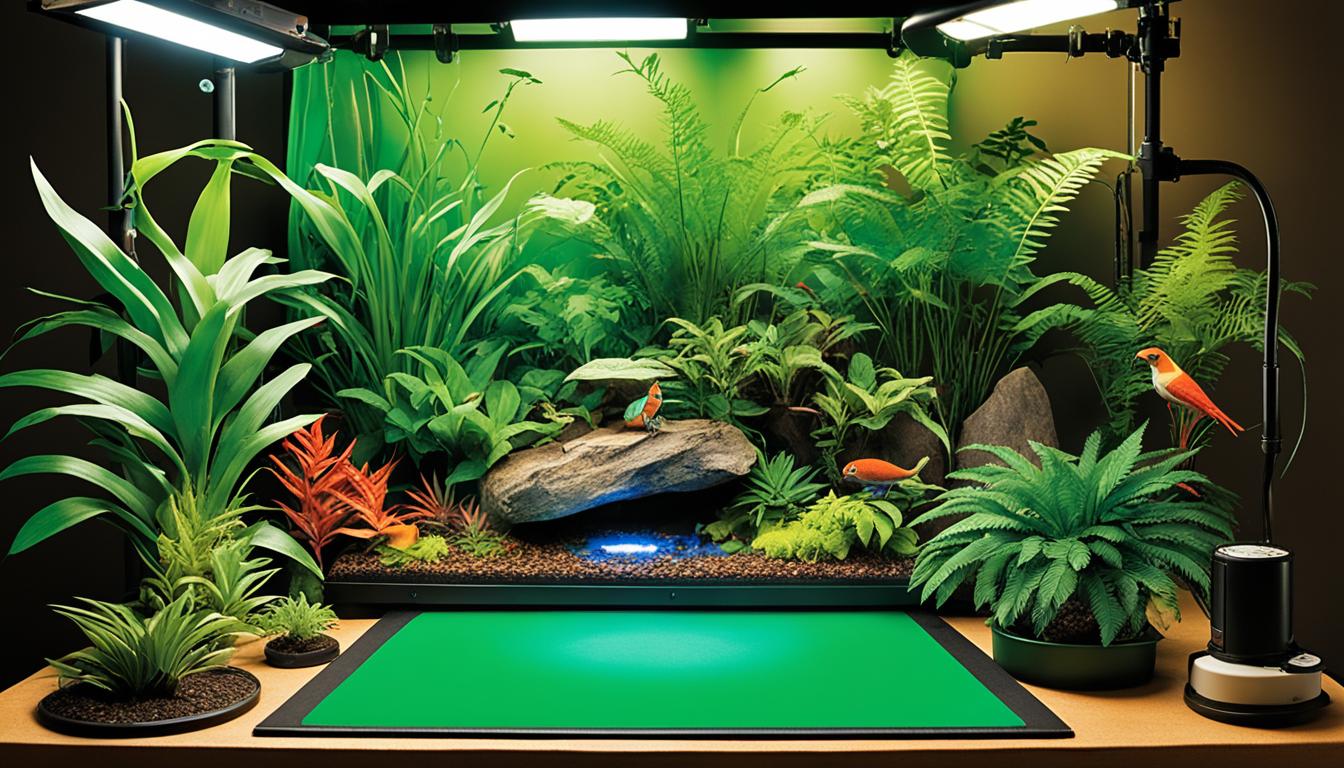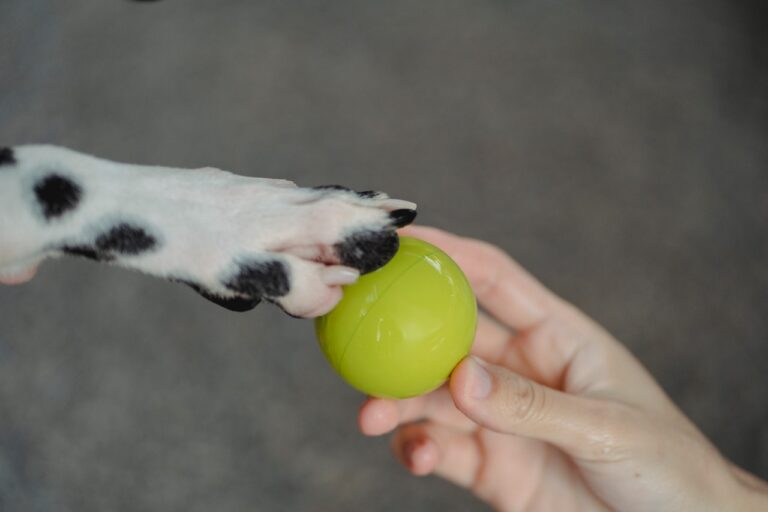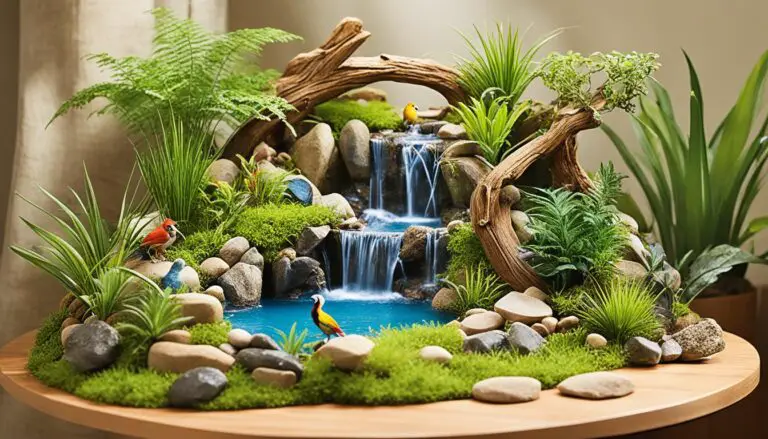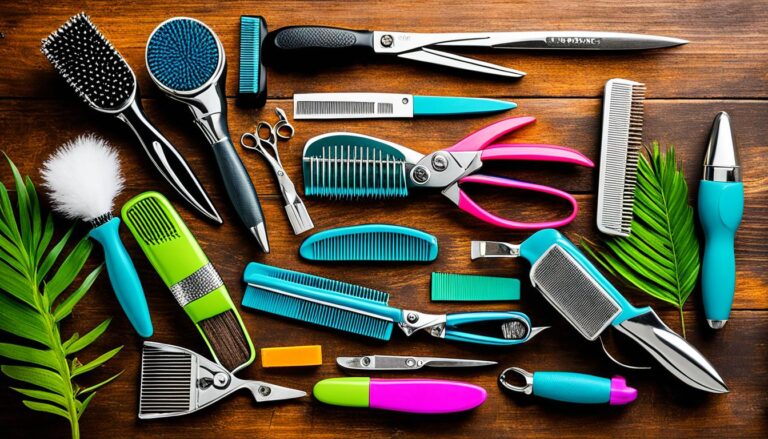Exotic Pet Heating & Lighting Equipment Guide
Did you know that proper heating and lighting are crucial for the well-being of exotic pets?
Creating a cozy terrarium for your exotic pet needs thought on heating and lighting. This guide will show you the importance of heating and lighting for your pet’s happiness. You’ll learn about lighting, picking the best lights, and the bulbs you can use. This includes both for light and heat.
Key Takeaways:
- Proper heating and lighting are vital for the physical and psychological well-being of exotic pets.
- Understanding the different types of ultraviolet (UV) light is essential for providing the right lighting for your pet’s terrarium.
- Consider your pet’s natural habitat and lighting preferences when choosing the right lighting for their terrarium.
- There are two main categories of bulbs for exotic pet terrariums: lighting bulbs and heat bulbs, each serving different purposes.
- Controllers such as timers, thermometers, rheostats, and thermostats can help manage your pet’s lighting and heating setup.
Why Heating and Lighting Are Important for Exotic Pets
Proper heating and lighting are key for the health of exotic pets. This includes reptiles and amphibians. They need their surroundings to keep the right body temperature. Without the correct heating and lighting, they can get sick.
Keeping the right temperature is vital for them. They can’t make their own body heat like mammals can. So, without enough warmth, they might get very tired, not eat, or get too cold.
Light is also crucial. It helps keep their daily and nightly routines in balance. Just as they would in the wild, these pets need light to know when to do things like eat, sleep, and reproduce.
Use a special heat lamp or lighting system for them. These tools give off infrared light, which warms their home without messing up their natural light patterns.
Understanding How Lighting Works for Exotic Pets
Lighting is key for the well-being of exotic pets. Different types of ultraviolet (UV) light play a big role. We will check out UVA, UVB, and UVC lights.
UVA Light: Regulating Behavior
UVA light supports reptiles’ life functions. It aids in behaviors like mating and eating. Reptiles use UVA light in nature to communicate, spot mates, and find food.
Adding UVA light in their tanks mimics their natural homes. This encourages important behaviors.
UVB Light: Essential for Health
Reptiles need UVB light for health. It lets them make vitamin D3. This vitamin helps with calcium and bone growth. Without UVB, they could get metabolic bone disease (MBD).
Special UVB bulbs exist for reptiles. Choose the right one for your pet and its tank size.
UVC Light: Not for Pet Lighting Setups
UVC light is used for sterilization. But, it’s not for pet use. It can harm reptiles. Focus on UVA and UVB lights for safety.
Knowing about UV light helps create a good living space for your pets. Now, let’s see how to pick the best light for your pet’s tank.
Choosing the Right Lighting for Your Exotic Pet’s Terrarium
Choosing the right lighting for your exotic pet is key. You have to think about the kind of light their wild cousins enjoy. This choice depends on whether your pet is most active during the day, at night, or at dawn/dusk.
Start by learning about your pet’s species and their natural home. Good research will guide you to mimic the perfect lighting inside their terrarium. You need to think about how strong the light is, how long it shines, and what color of light they need.
Diurnal pets, which like to be awake during the day, need lights that feel like sunlight. Use full-spectrum bulbs to mimic the sun’s natural glow. These bulbs are good for their health, as they help with digestion, staying warm, and making babies. They also provide UVB light for strong bones and a happy life.
If your pet is more active when the sun goes down, they need something different. Nocturnal pets love the quiet and soft light of the moon. Add a moonlight bulb to their home. This way, their night habits and sleep won’t be disturbed.
Some pets don’t fit neatly into day or night categories. They might like to hide from the sun or have their own, special lighting needs. Knowing exactly what your pet requires ensures their home is just right for them.
Getting the lighting right is crucial for your pet’s health and happiness. By copying their natural light at home, you’re creating a space where they can thrive.
Lighting Recommendations for Exotic Pet Terrariums
| Reptile Species | Lighting Requirement |
|---|---|
| Diurnal Reptiles | Full-spectrum bulbs for simulating daylight, including UVA and UVB |
| Nocturnal Reptiles | Moonlight or night-specific bulbs with lower light intensity |
| Crepuscular Reptiles | A combination of full-spectrum bulbs and dimmer lighting for dawn and dusk periods |
| Shaded Dwelling Species | Low light intensity with plenty of hiding spots and coverage |
| Unique Basking Behaviors | Specific lighting setups tailored to their unique basking requirements |
Please note that the lighting recommendations provided in the table are general guidelines. It is essential to research and consult species-specific habitat guides to determine the most appropriate lighting setup for your exotic pet.

Types of Bulbs: Lighting vs. Heating for Exotic Pets
Choosing the right bulbs for your exotic pet’s terrarium is key. There are two types: lighting bulbs and heat bulbs.
Lighting Bulbs
Fluorescent lighting bulbs are essential. They provide UVA and UVB light for reptiles and amphibians. These lights copy the sunlight these animals get in the wild, which helps keep them healthy and happy.
“Lighting bulbs are like a sun replacement for your pets. They provide the necessary light spectrum for essential biological functions, such as vitamin D synthesis and calcium absorption.” – Dr. Sarah Johnson, Herpetologist
Heat Bulbs
Heat bulbs, like incandescent or mini halogen, add warmth to the terrarium. They’re great for basking spots and keeping the night warm for your pets. This makes sure your pets are cozy and their home is just right.
Remember, heat bulbs are not a stand-in for lighting. While warmth is vital, reptiles and amphibians need the special light from lighting bulbs for their health too.
When you’re looking for bulbs, think about your pet’s lighting and heating needs. Be sure to research what your specific pet needs. Talking to veterinarians or experts can help you make the best choice for a happy, healthy pet.
| Type of Bulb | Function |
|---|---|
| Fluorescent Bulbs | Provide UVA and UVB light for reptiles and amphibians |
| Incandescent Bulbs | Generate heat for basking spots and nighttime warmth |
| Mini Halogen Bulbs | Produce focused heat for specific areas in the terrarium |
Controllers for Your Exotic Pet’s Lighting and Heating
Creating a comfy home for exotic pets needs special devices. Timers, thermometers, and other gadgets help keep the terrarium just right. They make sure the temperatures and lights are always perfect for your pet.
Timers
Timers are key to a pet’s terrarium. They control when lights and heat go on and off. This keeps your pet’s day consistent, like in the wild. It prevents light and temperature changes from stressing them out.
Thermometers
It’s vital to watch the terrarium temperature for pet health. Thermometers show if there are warm and cool spots. They make sure the overall temperature is right for your pet, keeping them healthy and happy.
Rheostats and Thermostats
Rheostats can dim lights or change the heat’s strength. They help match the setup to what your pet needs, so they feel at home. Thermostats stop things from getting too hot, keeping your pet safe.
“Controllers like timers and thermometers help create a perfect home for exotic pets.”
These devices make the terrarium just like their natural habitat. Your pet gets the right light and warmth with automatic adjustments. This means a safe and cozy place for them.
| Controller | Function |
|---|---|
| Timers | Automate the on/off cycle of lighting and heat sources |
| Thermometers | Monitor temperature gradient within the terrarium |
| Rheostats | Regulate power output and dim lighting |
| Thermostats | Regulate temperature and prevent overheating |

Designed for easy use, these controllers make your pet’s environment perfect. They ensure the terrarium is just right for your special pet.
Importance of Day/Night Cycles for Exotic Pets
Setting the right day/night cycle is key for your exotic pet’s health. Many reptiles need a 12-hour light cycle. This means lights on for 12 hours and off for 12 hours, similar to their wild environments. You should match the light hours with your pet’s daily habits to keep them happy.
Reptiles use a daily routine to stay healthy and active. Their internal clock adjusts to light and dark, influencing when they eat and rest.
The proper amount of daylight is crucial for your pet’s well-being. It affects their eating, sleeping, and energy levels. Without it, your pet might get sick or act strangely.
A stable day/night cycle at home helps your exotic pet feel comfortable. It keeps them healthy and stops them from getting stressed. By copying their wild light patterns, you can support their natural routines.
Take your pet’s species and living habits into account when setting up their day. Some are awake during the day, others at night, and some at dawn and dusk.
Benefits of Proper Day/Night Cycles for Exotic Pets:
- Maintaining a reliable day/night timing means your pet stays healthy and alert.
- Good lighting makes reptiles act as they would in nature, making them happier.
- The right light lets reptiles make vitamin D and use calcium well.
- Natural light rhythms keep exotic animals relaxed and enjoying life.
To make the most of the day/night cycle, keep the lighting steady. Timers or automatic lights are great for this, so you don’t have to adjust them all the time. It’s also good to talk to a vet or an expert to find the best light plan for your pet.
| Day/Night Cycle | Lighting Schedule |
|---|---|
| Diurnal Reptiles | 12 hours of light followed by 12 hours of darkness |
| Nocturnal Reptiles | 12 hours of darkness followed by 12 hours of dim, low-intensity light |
| Crepuscular Reptiles | Gradual lighting transitions at dawn and dusk |
UVB Lighting for Exotic Pets: Metabolic Bone Disease and Benefits
UVB lighting is vital for the health of some reptiles, keeping them safe from metabolic bone disease (MBD). MBD comes from not having enough calcium and vitamin D. It can lead to bad bone growth and poor health.
Not all reptiles need UVB, but it can make a big difference. It helps with many body functions. These include making vitamin D for strong bones.
- Vitamin D Production: Reptiles need vitamin D to use calcium well. UVB helps them make vitamin D in their skin. This keeps their bones strong and healthy, avoiding MBD problems.
- Calcium Absorption: UVB light makes it easier for reptiles to use the calcium in their food. This is key for their bones, muscles, and nerve health.
- Eyesight: UVB is also good for reptile eyes. It helps their eyes and nerves work right. This is important for hunting and finding their way around.
- Breeding Behavior: UVB is tied to good breedings in reptiles. It helps with hormones and mating triggers. This is important for their health and baby-making.
- Immune System Support: UVB boosts a reptile’s immune system. This helps them fight illness and stay healthy. It makes their whole immune system work better.
Reptile owners should look into what kind of UVB their pets need. Talking to a reptile vet is a good idea. Doing some research will help set up the best lighting for your pet’s home.
Did You Know? Even if a reptile gets outside sunlight, it can still benefit from UVB light inside.
Using UVB lights is key for keeping your pet reptile’s bones strong. But remember, they also need warmth. It’s important to get the right balance of UVB and heat to make a comfortable, healthy home for your pet.

UVB Requirements for Common Exotic Reptile Species
| Reptile Species | UVB Requirement |
|---|---|
| Bearded Dragon | UV Index 2-4 |
| Leopard Gecko | UV Index 0-1 |
| Crested Gecko | No UVB Requirement |
| Red-Eared Slider Turtle | UV Index 2-4 |
| Russian Tortoise | UV Index 2-4 |
Overhead Heating Options for Exotic Pets
Optimal heating for exotic pets can be achieved through various overhead options. PAR38 Halogen bulbs, Deep Heat Projectors (DHPs), and Ceramic Heat Emitters (CHEs) are some examples. Under-tank heat (UTH) mats are also available for this purpose.
PAR38 Halogen bulbs are popular for their balanced terrarium environment. They offer a mix of visible light and infrared heat mimicking natural sunlight. These benefits promote the well-being of various exotic pets.
Deep Heat Projectors (DHPs) represent another heating option. They emit all types of infrared heat, from near to far infrared. Perfect as a supplementary source, these projectors ensure a natural heat gradient in terrariums.
Ceramic Heat Emitters (CHEs) provide an economical solution. They mainly emit IR-C heat, ideal for creating warm basking spots. Since they don’t emit light, the terrarium’s day and night cycle feels natural.
However, under-tank heat (UTH) mats aren’t ideal as a primary heat source. They offer heat from the terrarium’s bottom, but it might not fully meet your pets’ heating needs.
It’s important to consider your exotic pets’ heat requirements and their habitats when choosing overhead heating methods. For the best advice, consider talking to a vet or reptile expert to create the ideal temperature for your pet’s health.
| Heating Option | Benefits |
|---|---|
| PAR38 Halogen bulbs | Provide a balance of visible light and infrared heat. Simulate natural sunlight. |
| Deep Heat Projectors (DHPs) | Produce all three types of infrared heat. Create a comfortable heat gradient. |
| Ceramic Heat Emitters (CHEs) | Economical option. Produce mainly IR-C heat. Suitable for basking spots. |
| Under-tank heat (UTH) mats | Not recommended as the sole heat source. Provide shallow-penetrating heat. |
The Importance of Thermogradient in Exotic Pet Enclosures
It’s important to keep a temperature gradient in your exotic pet’s enclosure. This helps them stay healthy. Reptiles, for example, need both warm and cool spots to stay healthy.
Creating a terrarium with a range of temperatures lets your pet choose. If a reptile needs to warm up, they can bask. If they need to cool down, they have spots for that too.
You should know what temperatures your pet needs. This depends on the kind of reptile and where it comes from. Do some research on your pet’s needs.

To make the right temperature set-up, use different heating tools. These could be heat bulbs or other devices. Make sure to control the temperature with a thermostat.
Right temperatures are essential for reptiles. They help with digestion, health, and avoiding stress.
Keep an eye on the temperature in your pet’s home. Use a good thermometer and adjust as needed. Always check that your heating tools are working correctly.
A good temperature range lets your pet act naturally. This makes them happier and healthier in their enclosure.
| Benefits of Thermogradient | Consequences of Inadequate Thermogradient |
|---|---|
|
|
Key Takeaways
- Maintaining a thermogradient in your exotic pet’s enclosure is essential for them to regulate their body temperature effectively.
- Reptiles require both warm and cool areas within their enclosure to meet their specific temperature needs.
- Proper thermogradient helps reptiles manage their metabolism, digestion, immune system, and circadian rhythm.
- Monitor and regulate temperatures in the enclosure using thermometers, heat sources, and temperature regulation tools.
- Achieving and maintaining the correct thermogradient ensures that your exotic pet can thrive in captivity and exhibit natural behaviors.
Rheostats and Thermostats for Exotic Pet Enclosures
Keeping your exotic pet’s home just right is vital. Rheostats and thermostats are key. They help keep the enclosure comfy and safe.
Rheostats act like dimmer switches for lights and heaters. You can change how much light or heat comes out. This makes sure your pet’s home is always the perfect temperature. It’s great for pets who love the sun or the shade.
Thermostats take it a step further by controlling the heat automatically. They check the temperature and adjust the heat output. This way, your pet’s home always stays at the right temperature.
Which one you pick depends on the size and power of your lights and heaters. Thicker devices might need a thermostat for exact control. If everything’s smaller, a rheostat is the best gear to use.
“Using rheostats and thermostats in your exotic pet enclosures can provide the necessary control over temperature and light intensity, ensuring a comfortable and safe environment for your pets.”
– Dr. Emily Harris, Exotic Pet Specialist
Benefits of Using Rheostats and Thermostats:
- Temperature Control: Rheostats change the power of lights and heaters. Thermostats keep the temperature right to avoid overheating.
- Precise Environment: These tools make sure your pet’s home stays at the best temperature and light level.
- Flexibility: Rheostats let you change the light and heat to meet your pet’s specific needs.
- Safety: Thermostats stop overheating, keeping pets safe and comfy.
Here’s a table to compare rheostats and thermostats:
| Rheostats | Thermostats | |
|---|---|---|
| Function | Adjust intensity of lighting and heating devices | Regulate temperature, prevent overheating |
| Control | Power output adjustment | Temperature range control |
| Suitable for | Smaller enclosures or lower wattage devices | Larger enclosures or higher wattage devices |
| Benefits | Flexible lighting and heat intensity | Precise temperature control and safety |
Rheostats and thermostats make it easy to create the perfect home for your exotic pet. They’re great for adjusting light or keeping the temperature consistent. These tools are essential for top-notch pet care.
Conclusion
For your exotic pet’s home, you need to think about the right heat and light. Make sure you know what kind of light your pet needs. Use the correct bulbs to keep them healthy. Also, use devices like rheostats and thermostats to control the temperature perfectly.
It’s important to know about your pet’s natural home and the kind of light it likes. Copy its original environment as much as possible. This helps your pet act naturally, staying healthy and happy.
Think of your pet’s space as more than just a glass box. It’s their living space. With the perfect heating and lighting, you build a great place. This not only makes them feel good but also makes your bond stronger.
FAQ
Why is heating and lighting important for exotic pets?
What types of ultraviolet (UV) light are important for reptiles?
How do I choose the right lighting for my pet’s terrarium?
What are the types of bulbs used in terrariums for exotic pets?
What devices can help manage my pet’s lighting and heating setup?
How long should the lights be on in my pet’s terrarium?
Why is UVB lighting important for reptiles?
What are some overhead heating options for exotic pets?
Why is maintaining a thermogradient crucial for exotic pets?
How can rheostats and thermostats help regulate my pet’s enclosure?
How do heating and lighting contribute to an optimal habitat for exotic pets?
Source Links
- https://www.zillarules.com/articles/the-ultimate-guide-to-lighting-and-heating
- https://www.hvreptilerescue.org/resources/heating-and-lighting-guide
- https://www.instructables.com/Reptile-tank-heating-and-lighting-guide/
Peter Stones is the founder of Exotic Pets Place, the leading online resource for exotic pet care information.
With over 10 years of hands-on exotic pet ownership experience, he is deeply passionate about sharing his expertise to help others properly care for their unusual pets.
When he's not writing extensively researched articles or connecting with fellow exotic pet enthusiasts worldwide, you can find Peter at home tending to his own beloved menagerie of exotic animals.







